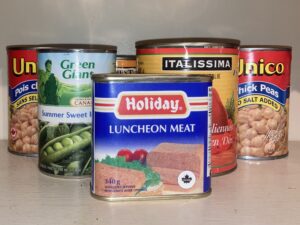To survive off of canned food is to billow in a sweltering breeze. The body bloated and subdued, still happy-go-lucky. Tins of beans and soups and peaches stew in their own thick fluids on grocery-store shelves and then on the buyer’s for several years with no consequence, not one spoil. Various items for consumption at suspicious temperatures mingle in the cupboard and wait for desperate stomachs. Meanwhile, an entire planet is on the fritz. In a time so dire, so uncertain, it is the year of the canned good.
A well-stocked pantry has never not been in style, but the quantity which the fridge will bear, I predict, is on the decline. Out with the per-pound food measurements, and in with the grams and millilitres.

I wouldn’t be the first, or even the second, to make an observation on the surging price of groceries. And indeed they will continue to go up. Canada’s Food Price Report for 2025 predicts that “based on the 2024 predictions, the total annual expenditure for a family with the following demographic composition: a man (aged 31-50), a woman (aged 31-50), a boy (aged 14-18), and a girl (aged 9-13), was projected to be $16,297.20. Based on the observed changes in 2024, a family with the same demographic makeup spent $16,032.07, a difference of $265.13.” This is to say by about five percent.
To chat unaffordability in a supermarket aisle is the glue that binds. “It is entirely unprecedented,” a mother of four says to the self-diagnosed anxious college student. “It’s impossible!” And it is. And then they purchase $75 worth of lettuce and find ways to forget.
The interaction happens in the cracker aisle, the freezer aisle, the cleaning, the baking, and the produce aisle, but in the quaint canned-goods corner of a Safeway, it is quiet.
It is true that the price of even cans has gone up; there are no blind spots to this inflation that has been going around. But what happens in the cool, dry pantry stays in the cool, dry pantry. Low-acid foods like luncheon meat and vegetables are in their prime to be eaten up to five years. And high-acid foods like tomatoes, jams, and pickles up to 18 months. But, so long as no rust, swelling, or dents are visible, canned foods are safe to eat indefinitely. (If rust, swelling, or dents are visible, do not ingest these canned items, as they may cause botulism, a life-threatening illness, terrible.)
Both the lifespan and value of canned goods make them increasingly attractive with most other items, inside and outside of the grocery store, priced above $5. An entire meal in one Campbell’s Chunky Chili is undeniably precious in a devastated economy.
In the midst of serious concerns over climate change and political spectacles too, it isn’t so absurd to even see the fridge be tossed away this year, making room for more shelved pantry space. Perhaps this will even spark a new interior design trend. The new lime wash. I predict this will begin foremost with the nouveau trad-wife, first doing her own canning with rustic-looking cursive labels, and then will move forward to the broader working class.
It would be unsurprising to see this trend manifest as well in the cooking-show and -book industry, teaching consumers how to “can up” their lives, with cheeky recipes for sardine sammies and cream of mushroom cocktails. This will likely be the “it” Christmas stocking stuffer of the year. However, one of these authors will surely have a scandal that puts canning into question.
But cans will not come alone to the Thanksgiving table this year, luckily. With them, I predict, will be freeze-dried foods, bottled water, powdered eggs, honey, instant coffee, and boullion cubes. I predict many who once were deemed freak doomsday preppers will soon be revered.
